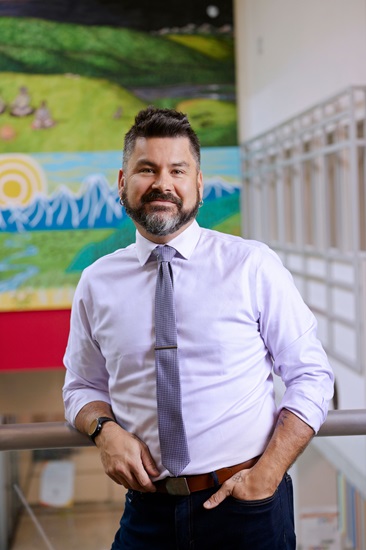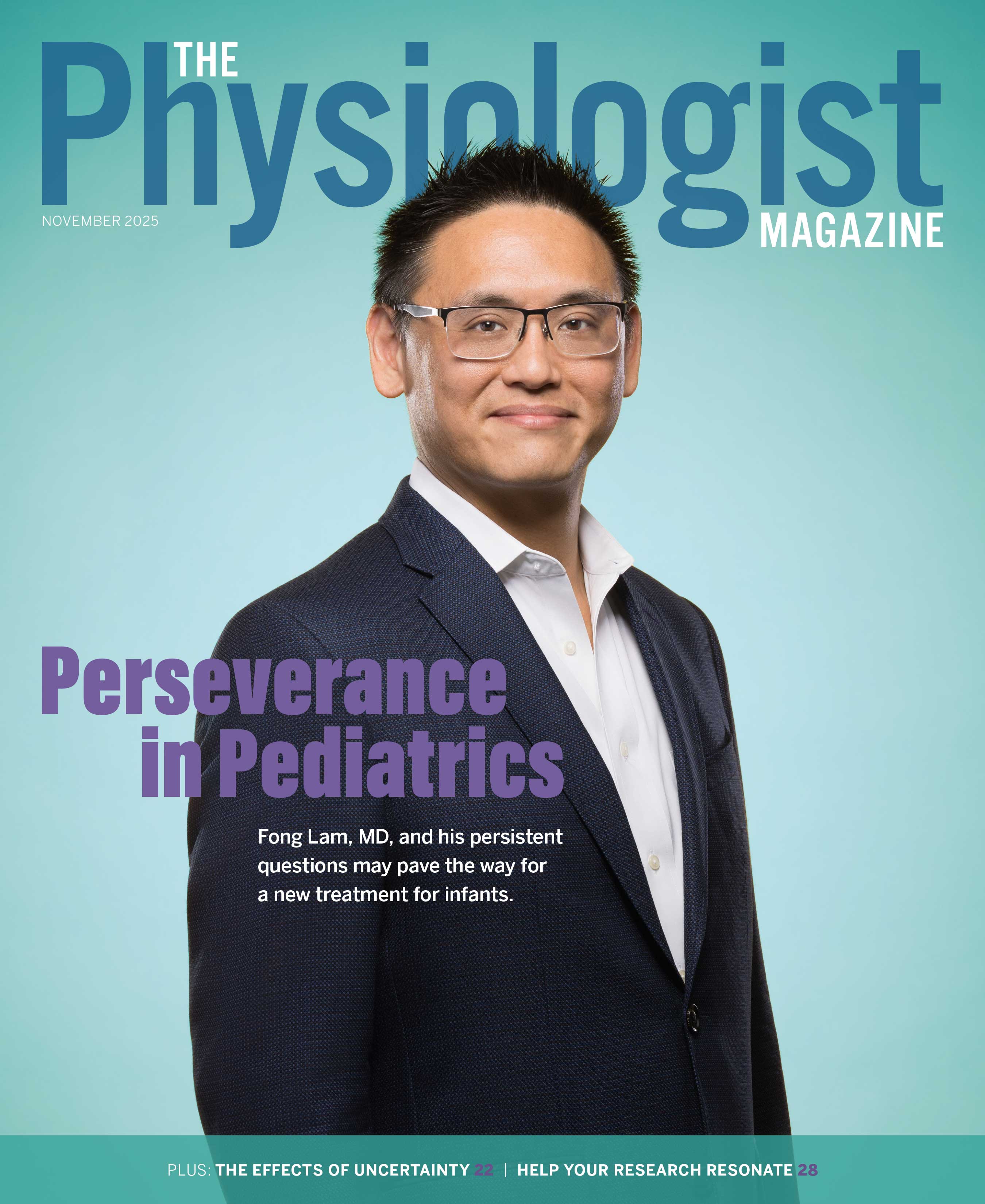Renaissance Researcher
Simon Hirota, PhD, enjoys exploring a wide mix of interests—both in and out of his lab.
By Melanie Padgett Powers

Simon Hirota, PhD, expected to become a professional hockey player when he grew up. He was a big kid—5’9” and 180 lbs. of mostly muscle by age 13—and good at hockey, playing in very competitive development leagues. Plus, his hometown was Brantford, Ontario, Canada, home of Wayne Gretzky, considered by many to be the greatest hockey player of all time. How could Hirota not play hockey?
Then, after ninth grade, he stopped growing, just as his peers started their growth spurts. With his hockey dreams dashed, he knew he’d have to go to college. His parents—dad, a math teacher; mom, a physiotherapist—had always emphasized education. So, Hirota headed to nearby McMaster University in Hamilton, Ontario, for undergrad. He had no idea what he wanted to do.
And then happenstance—and maybe even a practical joke—intervened before his junior year.
“This is a great story,” Hirota starts out. One of his roommates was working a summer job as an administrative assistant for a prestigious student program. With applications down, the program was mailing invite letters to eligible students. With mediocre grades, Hirota doubts he was on that list. But somehow he received a letter inviting him to apply. Did his roommate grab a letter and mail it to him. Was it a joke? A supportive gesture? Hirota isn’t sure, but he applied and was accepted.
Hirota is now an associate professor in the Department of Physiology and Pharmacology at the University of Calgary. That program in college was the Honors Biology and Pharmacology Co-op program. His first co-op experience was in an electrophysiology lab, doing intracellular recordings of membrane potential in smooth muscle.
“So, I ended up finding this program that I knew nothing about and realizing that it actually fit what I wanted to do,” Hirota says, “because it was focused on the applications of science versus just book learning. I could think on my feet, and it wasn’t about memorizing stuff anymore. It was actually about figuring out the problem and then trying to find a solution and generating hypotheses.”
Hirota liked working with his co-op mentor, Luke J. Janssen, PhD. So after graduation, he stuck around and started a master’s program under Janssen, then transferred into a PhD program with Janssen as his PhD mentor. Hirota studied the role of chloride channels on excitation-contraction coupling and calcium handling in airway smooth muscle.
Embracing Work-Life Balance
While all this was going on, Hirota picked up a new sport: racing mountain bikes. He even started a downhill mountain biking team with other cyclists in the area. “So, on the weekends, when we didn’t have tissue to work with, I’d race mountain bikes.”
Because Hirota rode his bike everywhere and often hung out at the local bike shop, the other cyclists thought he was a bike courier. “No one knew that I was studying the biophysics of pretty complex ion channel events,” he says, laughing.
That separation between the lab and his downtime continues today. Hirota recognizes how fortunate he is to live in the beautiful, outdoorsy Calgary area. Summers are short there, so when a perfect summer day arrives, he finishes his work early and heads into the sunshine. He can drive to a mountain bike trailhead in about 40 minutes, riding with friends for two or three hours. He encourages his lab team to do the same—get outside and enjoy Mother Nature.
In the winter, Hirota’s a Nordic, or cross-country, skier. In an hour, he can be at the Canmore Nordic Centre, where the 1988 Winter Olympics were held. “I can ski under the lights if I want to for 45 minutes,” he says. “We can ski in town as well.” Some of the local golf courses groom the courses for Nordic skiing in the winter.

Hirota also plays bass and sings backup in a band called Hellrazer. The band is led by his senior associate dean for research, Gerald Zamponi, PhD. Hirota previously played bass in an experimental folk band called Heart Failure Research Unit.
“People often see me as an individual who has a reasonable work-life balance, which is important to me because when I started this job and when I was a postdoc, I don’t think I had that work-life balance,” he says. “It’s hard to do when you’re starting out, but there’s got to be a way for us to make it better for people to not have to work 60- to 70- to 80-hour weeks. That just seems dumb to me.”
He’s even considered becoming a full-time administrator so he could have more influence over changing the academic culture to encourage better work-life balance. He already has a fairly large administrative portfolio, he says, including serving as animal ethics chair for the university’s Cumming School of Medicine.
Studying Smooth Muscle Cells and Gut Microbiota
When Hirota is in the lab, he’s not content to zero in on one very specific area of research. When he started his postdoctorate at the University of Calgary, he was researching smooth muscle in the gastrointestinal tract. But then his two mentors quickly changed their focus to epithelial biology and immunology. “Suddenly, I was thrown into this completely different world and felt remarkably inadequate for about a year and a half.”
But he soon adjusted and liked the work, so he stayed with epithelial biology and immunology, including when he opened his own lab in 2012 at the University of Calgary. His lab now has five team members.
Hirota’s interest and research quickly expanded. “Now, it’s all over the place,” he says. “We’re working on fibrosis in the gut, we’re working on host-microbe interactions and the impact on drug metabolism and developing intestinal organoid-based immune cell co-culture systems. If I’ve done anything right or wrong in my career, it’s been that I just go with what would interest me.”
Hirota has found success with this approach, admitting he may not have the depth in some areas, but he has a wide breadth of knowledge. He knows it’s about hiring the right lab team members with more expertise in certain areas. And he enjoys watching his lab team thrive and take ownership of their projects.
“It makes my job really satisfying to see them grow and develop, but it also makes my job a lot easier when they have the motivation and the confidence to take risks. I mean, otherwise I’d just hire robots.”
One area Hirota’s lab is studying could lead to better treatment for Crohn’s disease. The team is looking at how fibroblasts and smooth muscle cells contribute to some of the pathogenic remodeling that happens in Crohn’s disease.
The majority of people with Crohn’s disease will experience an intestinal obstruction from fibrostenosis at some point. The muscle gets thicker, narrowing the intestinal tube. “There’s not really anything we can do about it,” Hirota says, “because the therapies that address the inflammation don’t necessarily stop this remodeling and the narrowing of the tube.”
The only “treatment” is to cut out that part of the intestine. But blockages often reoccur.
The lab is also researching how an individual’s unique gut microbiota interacts with medication to change drug metabolism. “What we found is that depending on what vendor you might get your mice from, you’re likely going to see fairly drastic differences in how much drug gets to the systemic compartment, if you’re actually giving that drug via the oral route,” he explains. “And that’s all based on these different vendors having slightly different commensal microbiota compositions.”
If that’s the case, it means different labs will have different data depending on their mice populations, making it hard to standardize preclinical data results, he says.
Researchers have already seen this when studying a mouse model of colitis. Using the chemical mix dextran sodium sulfate (DSS) to induce colitis in mice is fairly common, but Hirota says various labs are getting different results, which is governed by the composition of the microbiota. That composition also likely drives how severe the disease and phenotype are, according to Hirota.
This brings up toxicity concerns for humans. Data have shown that people express different levels of enzymes inherent in their genome, which can affect how they metabolize a drug. “Now, we have to factor in the interplay between the host’s microbiota and the mucosal immune system, and layer it on top of that genomic input,” Hirota says. “So, suffice to say, it’s going to get remarkably complex if we actually want to do real precision, or personalized, medicine. But, it makes us understand how we have to probably contour dosing regimens to make sure that people get the same desired outcome—treatment efficacy versus toxicity.”
It also emphasizes the need to use more organoids in research rather than mice models. Hirota and colleagues from three universities are looking for funding to launch an effort that would develop a network across Canada to improve access to human-derived gut organoids for labs. They also want to standardize the protocols for harvesting, sending and using the organoids.
“We’ve been using mouse models for years, and people have been overselling the data generated from mouse models,” Hirota says, “and preclinical work fails when it moves to early human clinical trials because a human is not a mouse.”
This article was originally published in the November 2022 issue of The Physiologist Magazine.
“I ended up finding this program that I knew nothing about and realizing that it actually fit what I wanted to do because it was focused on the applications of science versus just book learning. I could think on my feet, and it wasn’t about memorizing stuff anymore.”
The Physiologist Magazine
Read the Latest Issue
Don’t miss out on the latest topics in science and research.
Contact Us
For questions, comments or to share your story ideas, email us or call 301.634.7314.


